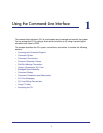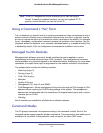
Using the Command-Line Interface
11
ProSafe M4100 and M7100 Managed Switches
Slot/Port Naming Convention
Managed switch software references physical entities such as cards and ports by using a
slot/port naming convention. The software also uses this convention to identify certain logical
entities, such as Port-Channel interfaces.
The slot number has two uses. In the case of physical ports, it identifies the card containing
the ports. In the case of logical and CPU ports it also identifies the type of interface or port.
Table 3. Type of Slots
The port identifies the specific physical port or logical interface being managed on a given
slot.
Table 4. Type of Ports
Logical Interface Represents a logical slot and port number. This is applicable in the case of a port-channel
(LAG). You can use the logical slot/port to configure the port-channel.
Character strings Use double quotation marks to identify character strings, for example, “System Name with
Spaces”. An empty string (“”) is not valid.
Slot Type Description
Physical slot numbers Physical slot numbers begin with zero, and are allocated up to the maximum
number of physical slots.
Logical slot numbers Logical slots immediately follow physical slots and identify port-channel (LAG) or
router interfaces.
CPU slot numbers The CPU slots immediately follow the logical slots.
Port Type Description
Physical Ports The physical ports for each slot are numbered sequentially starting from zero.
Logical Interfaces Port-channel or link aggregation group (LAG) interfaces are logical interfaces that
are only used for bridging functions.
VLAN routing interfaces are only used for routing functions.
Loopback interfaces are logical interfaces that are always up.
Tunnel interfaces are logical point-to-point links that carry encapsulated packets.
CPU ports CPU ports are handled by the driver as one or more physical entities located on
physical slots.
Table 2. Parameter Descriptions (Continued)
Parameter Description


















